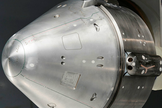
This artist’s illustration depicts a Boeing CST-100 spacecraft approaching a private inflatable space station complex designed by Bigelow Aerospace.
Credit: Boeing
The Boeing Co. is one of two companies funded by NASA to develop spacecraft for the International Space Station. Its CST-100 Starliner is expected to fly with an astronaut on board no earlier than 2017.
The firm is best known for its large passenger jets. In space, it has performed work on the space shuttle and the ISS, among other projects.
The CST-100 is similar in shape to the Apollo spacecraft, but should have electronics that are half a century more advanced. Its gumdrop shape also looks somewhat like the Orion Crew Exploration Vehicle being constructed right now by Lockheed Martin and its partners. Orion is designed to carry astronauts beyond low Earth orbit.

Boeing is testing a 12-by-14 inch aluminum model of its CST-100 space capsule in a wind tunnel at NASA’s Ames Research Center. The company has said it hopes the CST-100 will be flying astronauts to and from the International Space Station by 2015.
Credit: Boeing
Partners seeking business markets
The spacecraft is designed to carry up to seven astronauts, with additional cargo also possible if fewer astronauts fly in a particular mission. Measuring 14.8 feet (4.5 meters) across at its widest point, the gumdrop-shaped spacecraft will first fly into space aboard Atlas 5 rockets.
Boeing isn’t going at this venture alone. Another destination for its spacecraft could be an inflatable space station being proposed by Bigelow. As such, Bigelow has been committing some resources to the CST-100’s development. [Gallery: CST-100: Photos of Boeing’s Private Space Capsule ]
A few years ago, Boeing said it plans to grant Space Adventures, a space tourism company based in Virginia, the chance to sell any unused seats on the CST-100 for space tourism rides into low Earth orbit. However, the company has said it is not entirely sure what sort of business markets will arise for its spacecraft, if any.
“The market is obviously going to be there,” said John Mulholland, vice president and program manager for Boeing Commercial Programs, in a 2012 Space.com interview .
“I hope it’s in the near-term … but I’d say right now, it is soft because no one has been able to penetrate and really do it on a recurring basis. We’ll see.”
Money from NASA
Money for the development, however, is largely coming through NASA’s commercial crew program, which aims to largely replace the Russian Soyuz spacecraft flights required to bring astronauts to the International Space Station.
In the latest phase of the program, called Commercial Crew Transportation Capability (CCtCap), Boeing received $4.2 billion in September 2014. Competitor SpaceX received $2.6 billion for its Dragon spacecraft .
Credit: Karl Tate, SPACE.com Contributor
NASA is hoping to relaunch astronauts from American soil, which has not been possible since the space shuttle retired in 2011. The program has been pushed back several years, NASA has said, due to Congress not allocating as much money as what the agency requested.
Preparing for first flight
In 2011, the company put a 12-by-14 inch model of the CST-100 in a wind tunnel to determine the spacecraft’s aerodynamic characteristics. The model was placed in several different positions to simulate different phases of an abort-mode landing.
In 2012, Boeing did parachute drop tests of the CST-100 to determine how well the spacecraft’s parachutes and air bags worked. Unlike the Apollo missions, the CST-100 will touch down on land, making the air bags especially important for the job. Later in the year, the company and NASA determined what would be the basic layout of the spacecraft, which NASA considered an important milestone under the third round of CCDev.
In 2014, Boeing unveiled a full-scale mockup of the spacecraft at the Kennedy Space Center, showing the inside of it for the first time publicly. Airbag testing of the spacecraft proceeded successfully in February 2016, while a pad abort test is yet to come in 2017. The first operational flight of the system is expected shortly afterwards, depending on how certification goes.
Additional resources
Comments are closed.